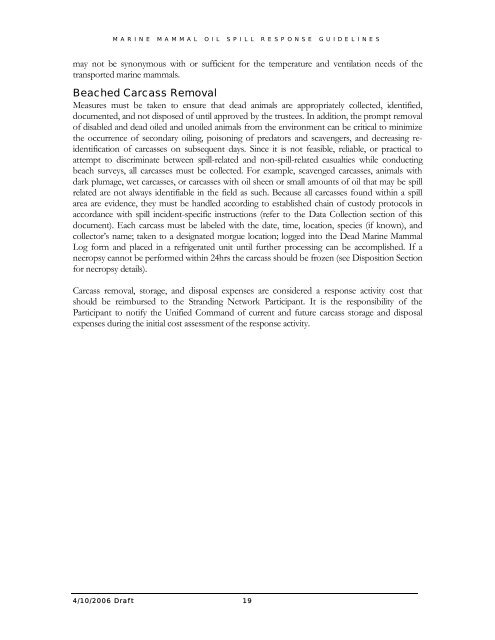Volume III, Appendices EM - National Marine Fisheries Service ...
Volume III, Appendices EM - National Marine Fisheries Service ...
Volume III, Appendices EM - National Marine Fisheries Service ...
Create successful ePaper yourself
Turn your PDF publications into a flip-book with our unique Google optimized e-Paper software.
MARINE MAMMAL OIL SPILL RESPONSE GUIDELINES<br />
may not be synonymous with or sufficient for the temperature and ventilation needs of the<br />
transported marine mammals.<br />
Beached Carcass Removal<br />
Measures must be taken to ensure that dead animals are appropriately collected, identified,<br />
documented, and not disposed of until approved by the trustees. In addition, the prompt removal<br />
of disabled and dead oiled and unoiled animals from the environment can be critical to minimize<br />
the occurrence of secondary oiling, poisoning of predators and scavengers, and decreasing reidentification<br />
of carcasses on subsequent days. Since it is not feasible, reliable, or practical to<br />
attempt to discriminate between spill-related and non-spill-related casualties while conducting<br />
beach surveys, all carcasses must be collected. For example, scavenged carcasses, animals with<br />
dark plumage, wet carcasses, or carcasses with oil sheen or small amounts of oil that may be spill<br />
related are not always identifiable in the field as such. Because all carcasses found within a spill<br />
area are evidence, they must be handled according to established chain of custody protocols in<br />
accordance with spill incident-specific instructions (refer to the Data Collection section of this<br />
document). Each carcass must be labeled with the date, time, location, species (if known), and<br />
collector’s name; taken to a designated morgue location; logged into the Dead <strong>Marine</strong> Mammal<br />
Log form and placed in a refrigerated unit until further processing can be accomplished. If a<br />
necropsy cannot be performed within 24hrs the carcass should be frozen (see Disposition Section<br />
for necropsy details).<br />
Carcass removal, storage, and disposal expenses are considered a response activity cost that<br />
should be reimbursed to the Stranding Network Participant. It is the responsibility of the<br />
Participant to notify the Unified Command of current and future carcass storage and disposal<br />
expenses during the initial cost assessment of the response activity.<br />
4/10/2006 Draf t 19
















